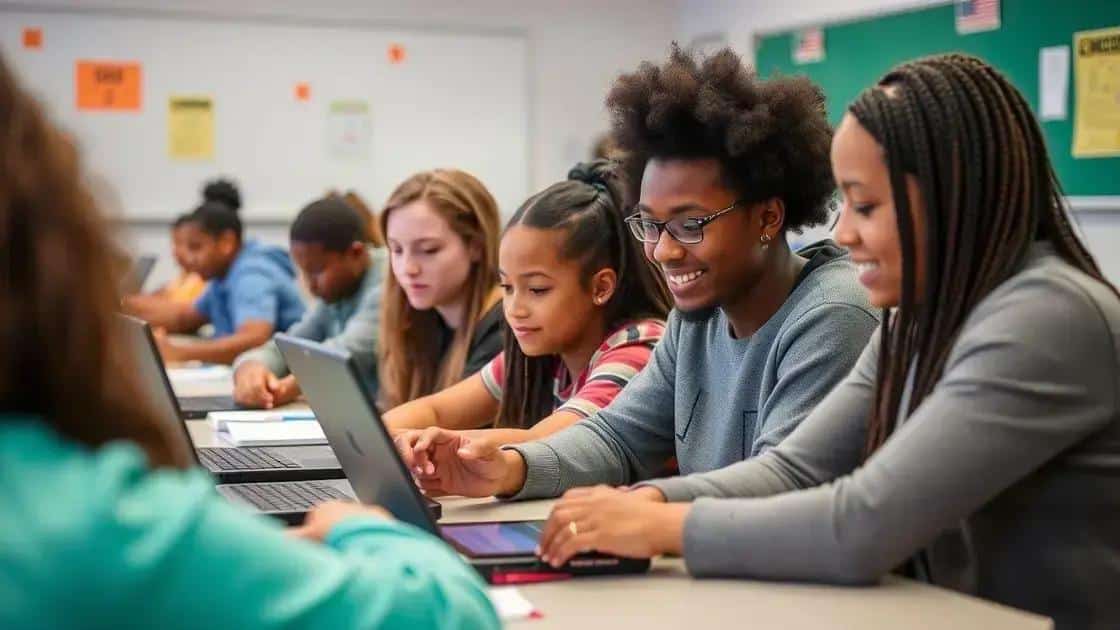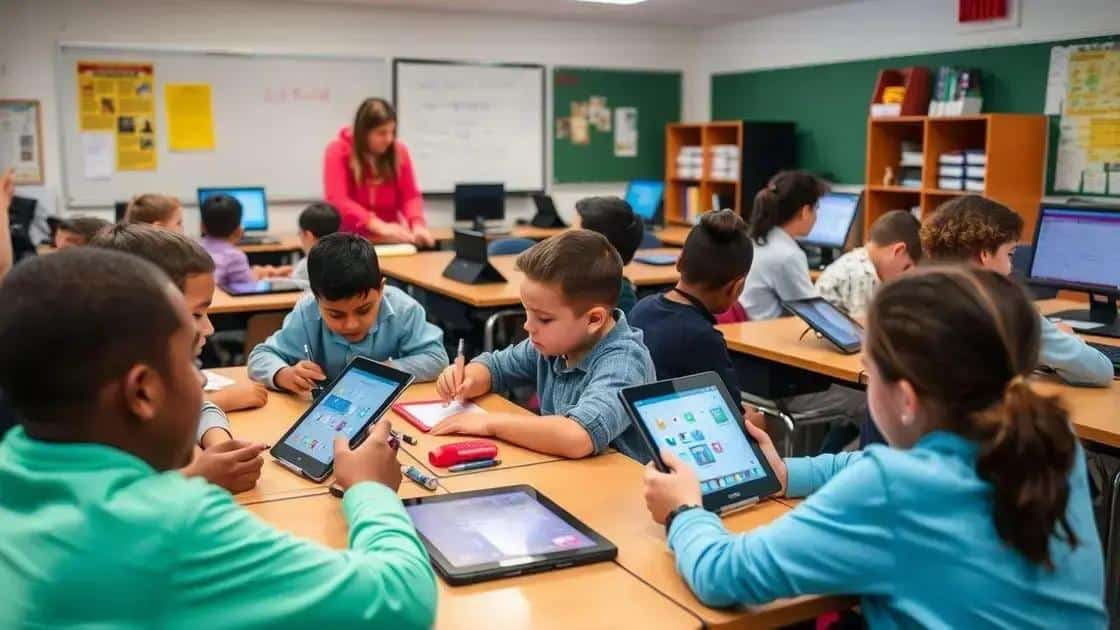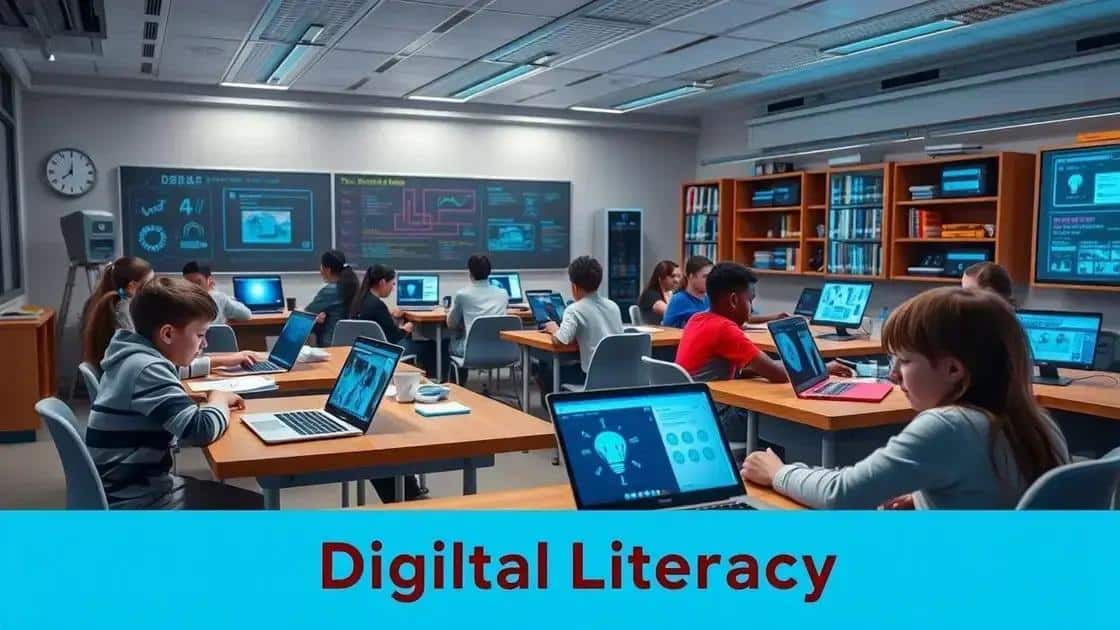Insights on digital literacy curriculum for modern education

Digital literacy curriculum incorporates critical thinking, effective communication, and digital citizenship to prepare students for a technology-driven world while addressing challenges like resource limitations and diverse learning needs.
Insights on digital literacy curriculum reveal a growing need for students to navigate the digital landscape effectively. With technology evolving, how prepared are our schools to equip learners with necessary skills? Let’s delve deeper into this vital topic.
Understanding digital literacy in contemporary education
Understanding digital literacy is crucial in today’s classrooms. As technology continues to advance, it becomes essential for students to master the skills needed to operate effectively in the digital realm. This modern form of literacy goes beyond basic computer skills; it must include the ability to evaluate information critically, communicate online responsibly, and engage with technology creatively.
To implement a strong digital literacy program, educators need to focus on several key areas:
Core Concepts of Digital Literacy
Digital literacy encompasses a variety of components that prepare students for real-world challenges.
- Information evaluation: Teaching students how to distinguish between credible and non-credible sources
- Online communication: Encouraging respectful and effective interaction in digital spaces
- Creative content creation: Fostering innovation through digital tools
- Safety and responsibility: Promoting safe online practices to protect privacy and personal information
As we dive deeper into digital literacy, it’s important to recognize the role of digital tools in fostering collaboration and engagement among students. Integration of various technologies can enhance learning experiences.
Moreover, educators should aim to create a curriculum that is adaptable. This flexibility allows for adjustments based on the students’ needs and the evolving nature of technology.
The Role of Educators
Teachers play a vital role in shaping how students interact with technology. By modeling effective use of digital tools, they can guide students in developing critical skills.
It’s essential for instructors to stay informed about technological advancements. This knowledge helps them integrate relevant tools into their lessons, ensuring that students receive a comprehensive education.
Furthermore, fostering a culture of digital literacy within the school encourages students to take responsibility for their learning. When students actively engage with technology, they become more adept at using it to enhance their educational experience.
Key components of an effective digital literacy curriculum

Creating an effective digital literacy curriculum involves incorporating several key components that ensure students gain essential skills. These components work together to prepare learners for a technology-driven world where digital skills are vital.
Essential Skills for Students
One major aspect of digital literacy is teaching essential skills needed in the digital age.
- Critical thinking: Students must learn to evaluate information sources carefully.
- Communication: Effective communication using digital platforms is crucial.
- Collaboration: Working with peers on digital projects enhances learning.
- Digital safety: Understanding privacy and security measures is essential.
A strong curriculum balances these skills, ensuring that students are not only consumers of information but also creators and critical thinkers.
Another important aspect is the integration of technology in learning environments. Using a variety of digital tools makes lessons engaging. For example, incorporating software for presentations or collaborative platforms helps connect theoretical knowledge to practical applications. The integration allows students to practice digital skills in real-life contexts.
Curriculum Adaptability
Flexibility in the curriculum is also essential. As technology evolves, so do the skills needed by students. Educators must regularly update their teaching strategies and materials to reflect current trends. This adaptability can lead to more relevant learning experiences.
Furthermore, assessment methods should focus on student understanding rather than rote memorization. Using project-based assessments allows students to demonstrate their skills effectively.
Finally, a successful digital literacy curriculum embraces diversity in learning styles. By offering varied instructional strategies, educators can meet individual needs, fostering a more inclusive learning environment.
Challenges in implementing digital literacy programs
Implementing effective digital literacy programs comes with several challenges that educators and schools must navigate. Identifying and addressing these obstacles is crucial for fostering an environment where students can thrive in a digital world.
Resource Limitations
One of the primary challenges is the lack of adequate resources. Many schools struggle with insufficient funding, which can hinder the acquisition of necessary technology and software.
- Outdated devices: Schools might have older computers that do not support new applications.
- Inadequate internet access: Not all schools have reliable internet connections, affecting online learning.
- Insufficient training: Teachers may not receive proper training on the latest technology, limiting their ability to teach effectively.
As a result, students may not be able to engage fully with the digital tools they need to learn effectively.
Another significant challenge is varying levels of student readiness. Educators often encounter classrooms with students who have differing abilities and experiences with technology.
Diverse Learning Needs
This diversity makes it difficult to create a one-size-fits-all approach. It requires educators to differentiate instruction, which can be time-consuming and complex. They must find ways to engage both tech-savvy students and those who may struggle with basic digital skills.
Additionally, teacher resistance to change can present a barrier. Some educators may feel overwhelmed by the rapid pace of technological change, leading to reluctance in adopting new methods. This attitude can affect students, causing a gap in digital skill acquisition.
It is essential for schools to offer professional development opportunities that empower teachers. When educators feel confident in their skills, they are more likely to engage their students effectively.
Parental Involvement
Lastly, parental support plays a crucial role in the success of digital literacy programs. Parents may not understand the importance of digital literacy, leading to a lack of reinforcement at home. Schools must actively involve parents, providing them with the tools and knowledge to support their children’s learning.
Creating strong partnerships between schools and families can enhance learning. When parents are informed and engaged, students are more likely to succeed.
Future trends in digital literacy education

The future of digital literacy education is evolving rapidly as technology continues to advance. Educators must stay ahead of trends to prepare students for an increasingly digital world.
Integration of Artificial Intelligence
Artificial intelligence (AI) will play a major role in shaping digital literacy programs. Schools can use AI to personalize learning experiences, adapting lessons to meet individual student needs. This allows for more effective skill development.
- Adaptive learning platforms can provide tailored content based on student performance.
- AI-driven analytics help teachers identify areas where students may struggle.
- Chatbots can assist in facilitating student inquiries and support.
The integration of AI will make learning more interactive and engaging, ultimately enhancing the overall educational experience.
Another trend is the focus on coding and computational thinking. As technology becomes a part of everyday life, understanding the basics of coding is essential. Schools are increasingly incorporating coding into their curriculums, making it accessible to younger students.
Emphasis on Collaboration Skills
Collaboration skills are becoming increasingly important in a digital context. This is due to the nature of modern workplaces, which often require teamwork across different platforms and locations. Schools are fostering these skills by integrating collaborative projects within their digital literacy programs.
Project-based learning is an effective approach to develop these abilities. Students work together on assignments, using digital tools to communicate and share ideas. This method not only builds technical skills but also enhances critical thinking and problem-solving.
Finally, the emphasis on digital citizenship is paramount. Educators must teach students how to be responsible consumers and creators of online content. Lessons on digital ethics, online safety, and respectful communication are essential components of a comprehensive digital literacy education.
digital literacy education is poised for exciting developments. As we embrace new technologies like AI, we not only enhance student learning but also prepare them for the challenges of tomorrow. Schools must focus on essential skills such as coding, collaboration, and digital citizenship. By addressing the challenges in implementing these programs, educators can create comprehensive and engaging learning environments that empower all students to thrive in a digital world.
FAQ – Frequently Asked Questions about Digital Literacy Education
What are the key components of a digital literacy curriculum?
Key components include critical thinking, effective communication, coding skills, and digital safety. These skills help students navigate the digital landscape.
How can AI enhance digital literacy education?
AI can personalize learning experiences, adapt lessons to individual needs, and provide analytics to help teachers support students effectively.
What role does collaboration play in digital literacy?
Collaboration is essential as it helps students develop teamwork skills necessary for the modern workplace, often facilitated through digital projects.
Why is digital citizenship important in schools?
Teaching digital citizenship equips students with the knowledge to behave responsibly online, fostering respectful interactions and protecting their privacy.





